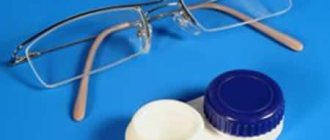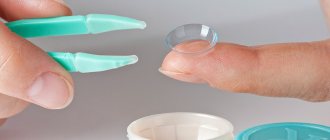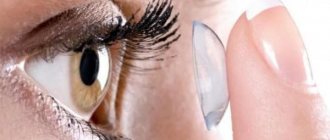The glasses are not fitted correctly
Strictly speaking, no one knows how to do it correctly. Because there is still no generally accepted standard for the selection of glasses, which all doctors and optometrists without exception must adhere to. Authors of various publications agree that before writing a prescription, you need to go through several successive stages, but these stages are always carried out in different conditions: doctor’s offices may vary in length and level of illumination, specialists may use different tests depending on their availability, the need for a particular case and the level of patient cooperation.
In addition, observations show that the results of examinations of the same patient can differ by ±0.50 D from the same specialist, and up to ±0.75 D from different specialists, even if everyone uses the same algorithm consisting of the same tests. This happens for various reasons. Doctors often interpret information received during a consultation differently, and the most modern instruments and examination methods always have an error in the repeatability of results. But the greatest variation comes from patient responses, which doctors and optometrists should rely on more than instrument data. This occurs because our vision fluctuates throughout the day and is affected by diseases, medications and the general condition of the body.
Therefore, the main criterion for the correct selection is still a trial wearing of glasses for 10-15 minutes and assessing their comfort. But even after this, it may take about 2 weeks to adapt, because a good prescription is not the only component of good glasses - the shape of the frame and the properties of the glasses play a huge role.
10 tips to help you quickly get used to new glasses
Why wear glasses over contact lenses?
Abroad, many people like to wear glasses along with contact lenses. This phenomenon is called GOC, which stands for glasses over contacts - glasses on top of optical products. Why is this being done?
Oddly enough, the combined use of spectacle and contact correction products has been known for a long time. The fact is that if you wear them at the same time, you can improve vision in case of ametropia (impaired refraction of the eye) and presbyopia (senile farsightedness).
How does this happen? The fact is that contact optics offered to the patient have minus diopters, while spectacle optics have positive diopters. Thus, when they are worn simultaneously, visual acuity increases (about 2–3 times), and the image formed on the retina increases, which ensures comfortable vision. In Russia, this method of vision correction is not particularly popular because of its high cost, although it is effective for senile farsightedness. Visually impaired people who are registered as disabled do not have that much money to buy glasses and contacts. In addition, it is worth considering that quite often patients with high degrees of refractive error are elderly people who do not know how to use optical products.
As mentioned above, on the contrary, there are many people abroad who like to wear glasses along with lenses, especially in European countries and America. In the latter, there are even special ophthalmological clinics that manufacture and select spectacle and contact lenses with high optical power.
Often GOC proponents wear glasses and contacts together not because of poor vision, but rather out of personal preference. Most people who use this wearing system simply like to attract the attention of others with an unusual accessory. They select glasses and lenses based on the principle of massiveness and visibility; they must have maximum optical power.
It happens that fans of this system choose glasses with minus diopters and a contact correction device with plus ones. Of course, such a wearing system is harmful to eye health, since in such models the size of objects is reduced and peripheral vision becomes blurred. Each person decides independently whether to use the GOC vision correction method or not. We advise you to use it only as prescribed by your attending ophthalmologist.
MagazinLinz.ru team
Consequences of wearing the wrong glasses
So, we found out that there is no correct way to select glasses. And except for the obvious cases when the plus is confused with the minus, and the right lens with the left, there is only one criterion by which the glasses can be considered incorrect - the patient could not get used to them.
Are these glasses dangerous? Most likely no. Even if you wear the wrong glasses for a very long time, the only problem will be symptoms of discomfort: eye fatigue, nausea, dizziness, headaches, blurred vision, distortion of the shape and size of objects, but there is no information about irreparable visual impairment in adult patients.
But in children, you can miss the moment to treat strabismus!
Read about the rules for prescribing glasses for children
What does a glasses prescription look like?
A sample prescription for glasses looks like this:
Left eye. Based on the prescription received, we can say that the person taking the test suffers from myopia. That is, he sees well up close, but poorly at a distance. His visual acuity is -2 diopters. The patient also suffers from astigmatism, so it is necessary to choose toric lenses. Their refractive power should be 2.5 diopters.
Right eye. The condition of the right eye is slightly worse. The optical power is 3.8 diopters. This eye also suffers from astigmatism, which requires a toric lens with a refractive power of 3.5 diopters.
The distance between the pupils is indicated on the glasses prescription form. It should be approximately 65 mm.
Sources
- MacKenzie G.E. Reproducibility of sphero-cylindrical prescriptions. Ophthalmic Physiol Opt. 2008;28(2):143–150. doi:10.1111/j.1475-1313.2008.00549.x
- Reinstein DZ, Yap TE, Carp GI, Archer TJ, Gobbe M; London Vision Clinic optometric group. Reproducibility of manifest refraction between surgeons and optometrists in a clinical refractive surgery practice. J Cataract Refract Surg. 2014;40(3):450–459. doi:10.1016/j.jcrs.2013.08.053
- Smith G. Refraction and visual acuity measurements: what are their measurement uncertainties?. Clin Exp Optom. 2006;89(2):66–72. doi:10.1111/j.1444-0938.2006.00022.x
- McMonnies C.W. Uncertainty of clinical measurements. Clin Exp Optom. 2006;89(5):332–333. doi:10.1111/j.1444-0938.2006.00064.x
- Leinonen J, Laakkonen E, Laatikainen L. Repeatability (test-retest variability) of refractive error measurement in clinical settings. Acta Ophthalmol Scand. 2006;84(4):532–536. doi:10.1111/j.1600-0420.2006.00695.x
- Leinonen J, Laakkonen E, Laatikainen L. Random measurement error in visual acuity measurement in clinical settings. Acta Ophthalmol Scand. 2005;83(3):328–332. doi:10.1111/j.1600-0420.2005.00469.x
- Dybkaer R. Result, error and uncertainty. Scand J Clin Lab Invest. 1995;55(2):97–118. doi:10.3109/00365519509089602
- Goss DA, Grosvenor T. Reliability of refraction—a literature review. J Am Optom Assoc. 1996;67(10):619–630.
- Shah R, Edgar DF, Rabbetts R, Harle DE, Evans BJ. Standardized patient methodology to assess refractive error reproducibility. Optom Vis Sci. 2009;86(5):517–528. doi:10.1097/OPX.0b013e31819fa590
- GOST R 51193-2009 Ophthalmic optics. Corrective glasses. General technical conditions
Point goals
The development of optics allows you to select glasses for different purposes. Modern lenses have many advantages and can not only improve the quality of vision of their owner, but also make life more comfortable.
There are several types of spectacle lenses:
- Aspherical . Such lenses are mainly used by motorists. Unlike the surface of conventional lenses, the surface of aspherical lenses thickens from the center to the edges. This allows you to get a uniform image both when looking to the side and to the center.
- Trifocal . The lenses have three zones. The lower one is necessary for working at close range, the central one for medium distances, and the upper one for working at a distance. These glasses are used for office work. They allow you to work with papers and a computer, while communicating with colleagues and clients.
- Monofocal . These are glasses with positive collective diopters. Used by people with farsightedness for reading.
Step-by-step instructions: How to choose glasses so as not to spoil your vision
There are so many new and interesting things in optics now that it’s worth taking advantage of it, doctors urge. Photo courtesy of the hero of the publication.
Ophthalmologists advise checking your vision every year, regardless of whether you have complaints or not. Most of us do not follow this recommendation and turn to specialists only when problems arise: it is difficult to look at price tags in stores, sign documents, or check children’s homework. Some, however, even in this case want to get everything done as quickly as possible - in the best case, they go to the nearest optician and buy suitable glasses, in the worst case, they choose their own means of correction. But incorrectly selected glasses or lenses can cause harm instead of benefit. On the air of the “Healthy Conversation” program on Radio “Komsomolskaya Pravda in St. Petersburg” (92.0 FM), Nina Troitskaya, chief physician of the Nevskaya Optika optical chain, told where and how to choose the right glasses, how to recognize good optics and what opportunities modern ones have means of correction.
Chief physician of the Nevskaya Optika optical chain Nina Petrovna Troitskaya.
Photo: Andrey GASHEV
Step 1: choose optics
To ensure that your glasses or lenses help you see and not aggravate existing problems, you need to choose them correctly. And for this you should contact a professional optician. The choice of such salons today is very large, but how do you know that they will really help you?
— First of all, evaluate the appearance of the salon and medical office. If it's a cramped space where the vision test is formal, it's best to look for a different optic. A medical office in an optician's office where vision is tested must have an area of at least 12 square meters. The distance from the eyes to the table is at least 5 meters, advises Nina Troitskaya.
Speaking of tables: in modern optics, instead of paper posters, projectors or projection screens are used.
“Then you need to look at the equipment that the office is equipped with. Mandatory instruments include an autorefractometer, a set of spectacle lenses, a slit lamp, a lensmeter or dioptrimeter, and a phoropter is highly desirable. If an ophthalmologist sees an optician, then additional equipment is needed, adds Nina Troitskaya.
And, of course, salon licenses and specialist certificates. The license specifies the type of activity of optics - this can only be medical optics - selection of correction products, then optometrists work in optics and their task is to correctly select glasses or lenses. If in addition there is a license in ophthalmology, then the salon employs ophthalmologists who can diagnose eye health. The capabilities of such optics are much wider.
— Unfortunately, today there are not enough professional optometrists and some salons are staffed by people without specialized education. Therefore, be sure to clarify this point, because it is your health, advises the chief doctor of Nevskaya Optics.
And also - you just have to feel comfortable in the optics! Photo courtesy of the hero of the publication.
Step 2: Choosing glasses
If vision problems arose at a young age, then you will most likely need single-vision glasses - with their help you can see at any distance. But with age, people’s vision “indicators” often become different – one value for distance, another for near. Previously, the problem was solved by buying more glasses, but over time they were replaced by bifocal glasses, which combine two types of lenses. Nowadays, glasses with two zones are considered not very comfortable, because in addition to the need to see distant objects and read at close range, our eyes now have another task - to interact with the computer and gadgets. There is a solution: progressive glasses or multifocal lenses that provide good quality vision at different distances.
— After 40 years, almost everyone needs progressive or multifocal lenses. And here there is an important point: the sooner we start wearing them, the faster we get used to it and feel comfortable. But after 50 years, it can be difficult to get used to such glasses, adds the ophthalmologist.
Once upon a time, all eyeglass lenses were made of glass, but now glasses with glass lenses are rare.
— The world is changing and today lenses are mainly made from polymer materials. They are lighter, more practical and, most importantly, safer. A modern person wants not only to see clearly, but also to look good. Lenses made of polymers cope well with this task - they are elegant, aesthetic and at the same time functional, says Nina Troitskaya.
Step 3: add “chips”
The choice of progressive lenses for glasses today is huge. You can choose photochromic glasses, which change color depending on the lighting in the room, or choose special driving glasses that remove glare from the asphalt. Sun protection progressive lenses are another very convenient option.
To make glasses last longer, they are given a special coating that either protects the lens from scratches, provides an anti-reflective effect, or has water-repellent properties. If desired, all these coatings are applied simultaneously, however, such glasses will cost more. And, of course, lenses need care.
— There are so many new and interesting things in optics now that it’s worth taking advantage of it! - adds Nina Troitskaya.
Listen to the “Healthy Conversation” program on Radio “Komsomolskaya Pravda in St. Petersburg” (92.0 FM) to learn how to “read” the licenses of optical salons, what to look for when choosing spectacle lenses and what aesthetic features modern correction means have. .











